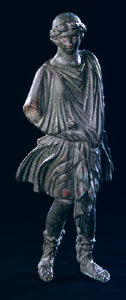Sculpture of a Lar with Inlaid Silver Eyes, 1st Century CE - 2nd Century CE
Bronze
height 15.9 cm
height 6 1/4 in
height 6 1/4 in
FZ.358
In the presence of the greatest artistic depictions of the human form, we are left not only awe-struck and inspired, but also slightly embarrassed. The presence is so undeniably real,...
In the presence of the greatest artistic depictions of the human form, we are left not only awe-struck and inspired, but also slightly embarrassed. The presence is so undeniably real, so irrevocably permanent, we of mortal flesh are made to feel as though we are imperfect and decaying imitations of the austere and silent forms that we run our hands and eyes across. Such a piece is this- for has ever any cloth billowed with as much richness, moved with such taught and intricate line as the supple folds of this toga suggest? Has the soil ever felt such tight and bold leather as the lustrous lines of these bronze sandals traces? Has a face so sublimely aristocratic- with cheeks that plane down so softly, with eyes so imploringly intelligent, with a brow so firm, ever cracked supple metal lips to utter a word? The genius who forged this masterpiece had a vision beyond sight. He did not capture what was human, but rather expressed a potential that the human form has yet to witness in actuality. The beauty of this Lar is truly worthy of its divinity. It is a timeless masterpiece that is more expressive and moving than pieces many times its size. While we may not offer it sacrifice, or expect its protection over our home, we undoubtedly bask in its beauty with just as much gratefulness and wonder as its original owners must have. This statue represents the spiritual guardian of an Ancient Roman household. Most striking about this figure is his silver inlaid eyes. He appears to gaze back at us through the solid bronze. His wavy hair is held in place by a headband. However, his curls fall out over his forehead and cover his ears. He wears a long-sleeved tunic that is elegantly wrapped around his waist and over his shoulder. The folds of the tunic flap in the breeze while the excess fabric falls in a zigzag pattern between his legs. He wears high sandals with animal skin flaps. This statue was a protector of families and the structure they inhabited. It warded off ill omens and evil spirits much like a horseshoe does today. Throughout time, the motivations of man do not change, just the forms of their superstition.
Literature
V29
